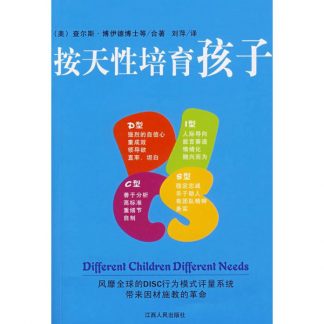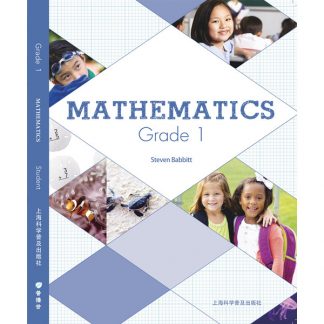描述
| 报佳音号 | 5823 |
|---|---|
| 外文书名 | Mathematics, Grade 1 |
| 作者 | [美]斯蒂文·白比特(Steven Babbitt) |
| ISBN | 978-7-5427-7163-6 |
| 出版社 | 上海科学普及出版社 |
| 出版年月 | 2018.3 |
| 开本 | 16K |
| 页数 | 387 |
《小学一年级全英文数学教材》编写原则
学习是学生构建自己世界的过程。这是构建理论的核心。以往的教育理念集中在知识的传递方面,教育的核心问题围绕着传递什么,如何传递来展开。但是越来越多的研究发现,尽管学校完成了知识的传递过程,并且也是有用的知识,但是被雪藏了。中国人从小到大引以为豪的数学成绩,成年后很少有用武之地。这种现状不仅仅发生在中国,美国也有。就是学完之后,都还给老师了。现代教育理论证明如果学习到的知识,不能够用于学生的自我构建上,那么这些知识就会被尘封。因此教育的核心转变为点燃学生的内驱力,变被动接受为主动寻找知识。为了完成这样的教学目标,有几个原则需要遵守:
- 尊重孩子的认知发展规律
- 调动孩子的多感官认知
- 敏锐孩子的感觉,在理性的帮助下不断升华
- 教师可根据学生的兴趣随时扩展教学内容
《小学一年级全英文数学教材》的特色
1、美国专业教育团队历史7年精心编写,2017年最新改版,全球超过1000所私立学校采用,每年超过200,000学生在使用这套书。编写者既有大学教授,也有教学经验丰富的一线教师。
2、每册174课时,15大类知识点,循序渐进的教学理念。
3、每册近400页全彩色高精度印刷,生动形象的教学风格。
4、注重动手操作,从实际的生活中抽象出数学概念。
《小学一年级全英文数学教材》内容简介
这是一本全英文小学一年级数学教材,适合具有一定英文基础的父母和老师使用。
这套教材由美国普播世出版社(Purposeful Design Publications)出版,教材出版后广受私立学校的欢迎。目前全球有1000多所学校使用,每年有200,000名学生受益。教材的编写始于1999年,第一版于2006年上市,历时7年。第二版成形于2014-2016年,于2017年上市。我们目前推出的是2017年的最新版。
教材的编写者在编写时,充分体现了最新的美国教学理论——构建理论在数学教学中的应用,强调引发学生的好奇心,尊重学生认知的发展规律,试图帮助学生构建起各自不同的数学世界。在知识点的教学顺序和教学难度上都进行了精心的设计。同样的知识点在各年级的难度都略有不同,介绍的方法亦有不同。同时又强调数学计算能力的重要性,重视数学学习中需要必须遵守的规范,是一套不可多得的幼儿园/学前班和小学数学教材。
如何使用《小学一年级全英文数学教材》?
这套教材既可以独立使用,也可以和现有的学校教材配合使用。如果将这套教材和人教版的数学作比较,总体来说,年级越高,普播世数学学到的“知识点”就要比人教版的多。然而如果大家不再把数学看作计算和背公式的一门学科,普播世数学会比人教版的数学有趣得多。
全套教材,每个年级都有174课时,包含了复习课。除了学前班,每三章会有一次阶段复习,全书最后有总复习。通常一学年有180天在校上学,你可以每天一课在家教授,也可以根据孩子的情况,有选择地完成书上的练习。
《小学一年级全英文数学教材》目录
Chapter 1 Getting Started
- 1.1 Everyday Routines …………………………..3
- 1.2 Sort Sets………………………………………..5
- 1.3 Attributes ………………………………………7
- 1.4 Patterns: AB, ABB, ABC……………………9
- 1.5 Identify Patterns……………………………11
- 1.6 Count to 20 ………………………………….13
- 1.7 Use Tally Marks……………………………..15
- 1.8 Numerals and Numbers 1–6……………17
- 1.9 Numerals and Numbers 7–9 ……………19
- 1.10 Write Numerals: 1–12…………………….21
- 1.11 Write Numerals: 13–20…………………..23
- 1.12 Sequence, Even, and Odd ………………25
- 1.13 Count Back from 20……………………….27
- 1.14 Chapter 1 Review ………………………….29
Chapter 2 Shapes, Sets, and Counting
- 2.1 Rectangle, Triangle, Hexagon………….33
- 2.2 Trapezoid and Rhombus …………………35
- 2.3 Circle and Oval ……………………………..37
- 2.4 Open and Closed Figures ……………….39
- 2.5 Shape Reflection……………………………41
- 2.6 Shape Translation ………………………….43
- 2.7 Shape Rotation……………………………..45
- 2.8 Count and Compare Sets………………..47
- 2.9 Count by 2s ………………………………….49
- 2.10 Count by 5s ………………………………….51
- 2.11 Count by 10s ………………………………..53
- 2.12 The Hundred Chart………………………..55
- 2.13 Ordinal Numbers …………………………..57
- 2.14 Patterns in Counting………………………59
- 2.15 Chapter 2 Review ………………………….61
Chapter 3 Addition and Subtraction Facts
- 3.1 Addition: Combining Sets……………….65
- 3.2 Horizontal Format …………………………67
- 3.3 Introducing Subtraction………………….69
- 3.4 Fact Families: 2, 3, and 4………………..71
- 3.5 Fact Families: 5 and 6…………………….73
- 3.6 Vertical Format……………………………..75
- 3.7 Fact Families: 7……………………………..77
- 3.8 Fact Families: 8……………………………..79
- 3.9 Fact Families: 9……………………………..81
- 3.10 Fact Families: 10……………………………83
- 3.11 Count On: Sums to 12 ……………………85
- 3.12 Count Back: Subtract from 12 …………87
- 3.13 Multiple Addends………………………….89
- 3.14 Add Doubles to 10 ………………………..91
- 3.15 Chapter 3 Review ………………………….93
- 3.16 Chapters 1–3 Review……………………..95
Chapter 4 Time and Money
- 4.1 Calendar and Schedule…………………..99
- 4.2 Time to the Hour…………………………101
- 4.3 Time to the Half Hour…………………..103
- 4.4 Time to the Quarter Hour……………..105
- 4.5 Time: Count by 5s………………………..107
- 4.6 Practice Telling Time…………………….109
- 4.7 Problem Solving: Time………………….111
- 4.8 Pennies, Nickels, and Dimes ………….113
- 4.9 Nickels and Dimes ……………………….115
- 4.10 Compare Sets of Coins …………………117
- 4.11 Count Coins to One Dollar ……………119
- 4.12 Problem Solving: Coins…………………121
- 4.13 Coins: Add and Subtract……………….123
- 4.14 Chapter 4 Review ………………………..125
Chapter 5 Place Value
- 5.1 Sets of 10 …………………………………..129
- 5.2 Counting Tens and Ones……………….131
- 5.3 Two-Digit Numerals ……………………..133
- 5.4 Zero in the Ones Place …………………135
- 5.5 Picturing Place Value ……………………137
- 5.6 Place Value with Coins………………….139
- 5.7 Two-Digit Addition ………………………141
- 5.8 Two-Digit Subtraction…………………..143
- 5.9 Checking Answers ……………………….145
- 5.10 Problem Solving: Place Value ………..147
- 5.11 Hundreds Place……………………………149
- 5.12 Hundreds, Tens, and Ones…………….151
- 5.13 Hundred Chart Patterns ……………….153
- 5.14 Chapter 5 Review ………………………..155
Chapter 6 Measurement
- 6.1 Explore Length……………………………159
- 6.2 Inches ………………………………………..161
- 6.3 Centimeters………………………………..163
- 6.4 Inches and Centimeters ………………..165
- 6.5 Feet and Yards…………………………….167
- 6.6 Centimeters and Meters……………….169
- 6.7 Three-Dimensional Shapes…………….171
- 6.8 Capacity……………………………………..173
- 6.9 Cups, Pints, Quarts, and Gallons ……175
- 6.10 Liters …………………………………………177
- 6.11 Pounds and Kilograms………………….179
- 6.12 Temperature ……………………………….181
- 6.13 Choose the Best Tool……………………183
- 6.14 Chapter 6 Review ………………………..185
- 6.15 Chapters 4–6 Review……………………187
Chapter 7 Using Numbers to 100
- 7.1 100 Days of School………………………191
- 7.2 Fact Families to 6 ………………………..193
- 7.3 Fact Families to 12 ………………………195
- 7.4 Multiple Addends………………………..197
- 7.5 Missing Addends …………………………199
- 7.6 Place Value to 100……………………….201
- 7.7 Count On by 10s …………………………203
- 7.8 Count On and Back………………………205
- 7.9 Problem Solving: Counting On ………207
- 7.10 More and Less …………………………….209
- 7.11 Greater Than and Less Than ………….211
- 7.12 Problem Solving: Using Pictures …….213
- 7.13 Comparison Signs………………………..215
- 7.14 Place Value: Add and Subtract ………217
- 7.15 Chapter 7 Review ………………………..219
Chapter 8 Fractions
- 8.1 Fractions…………………………………….223
- 8.2 Halves………………………………………..225
- 8.3 Thirds…………………………………………227
- 8.4 Fourths ………………………………………229
- 8.5 Halves of a Set…………………………….231
- 8.6 Thirds of a Set …………………………….233
- 8.7 Fourths of a Set…………………………..235
- 8.8 Fractional Parts……………………………237
- 8.9 Writing Fractions …………………………239
- 8.10 Problem Solving: Fractions ……………241
- 8.11 Fractions on Geoboards ………………243
- 8.12 More Fractional Parts …………………..245
- 8.13 Practice with Fractions …………………247
- 8.14 Chapter 8 Review ………………………..249
Chapter 9 Two- and Three-Digit Numbers
- 9.1 Addition: Sums to 18……………………253
- 9.2 Subtraction: Differences from 18……255
- 9.3 Use a Calculator…………………………..257
- 9.4 Add with Ten-Frames……………………259
- 9.5 Subtract with Ten-Frames ……………..261
- 9.6 Add with Base 10 Blocks ………………263
- 9.7 Subtract with Base 10 Blocks ………..265
- 9.8 Add with Tens Mats ……………………..267
- 9.9 Subtract with Tens Mats ……………….269
- 9.10 Base 10 Blocks: Three Digits …………271
- 9.11 Add Large Numbers …………………….273
- 9.12 Subtract Large Numbers ………………275
- 9.13 Problem Solving: Large Numbers …..277
- 9.14 Chapter 9 Review ………………………..279
- 9.15 Chapters 7–9 Review……………………281
Chapter 10 Graphs and Maps
- 10.1 Venn Diagrams ……………………………285
- 10.2 Graphs……………………………………….287
- 10.3 Pictographs ………………………………..289
- 10.4 Bar Graphs………………………………….291
- 10.5 Bar Graphs: Sorting……………………..293
- 10.6 Bar Graphs: Make a Table……………..295
- 10.7 Problem Solving: Graphs ………………297
- 10.8 Area…………………………………………..299
- 10.9 Explore Area……………………………….301
- 10.10 Coordinate Graphs ………………………303
- 10.11 Maps………………………………………….305
- 10.12 Maps: Follow Directions ……………….307
- 10.13 Graphs: Compare Information……….309
- 10.14 Chapter 10 Review ………………………311
Chapter 11 Problem Solving
- 11.1 Clue Words for Addition……………….315
- 11.2 Counting On to Add…………………….317
- 11.3 Clue Words for Subtraction …………..319
- 11.4 Solve for Missing Addends……………321
- 11.5 Using Fact Families………………………323
- 11.6 Add or Subtract ………………………….325
- 11.7 Extra Information ………………………..327
- 11.8 Measurement………………………………329
- 11.9 Money ……………………………………….331
- 11.10 Time ………………………………………….333
- 11.11 Two-Digit Numbers………………………335
- 11.12 Drawing to Solve Problems …………..337
- 11.13 Probability ………………………………….339
- 11.14 Estimation ………………………………….341
- 11.15 Chapter 11 Review ………………………343
- 11.16 Chapters 10–11 Review………………..345
Chapter 12 Cumulative Review
- 12.1 Review: Patterns and Counting ……..349
- 12.2 Review: Shapes……………………………351
- 12.3 Review: Addition and Subtraction….353
- 12.4 Review: Money ……………………………355
- 12.5 Review: Time ………………………………357
- 12.6 Review: Place Value……………………..359
- 12.7 Review: Length……………………………361
- 12.8 Review: Capacity and Weight………..363
- 12.9 Review: Count and Order Numbers .365
- 12.10 Review: Fractions ………………………..367
- 12.11 Review: Two-Digit Numbers ………….369
- 12.12 Review: Graphing ………………………..371
- 12.13 Review: Problem Solving………………373
- 12.14 Chapter 12 Review ………………………375
Table of Measures………………………………….379
Glossary ……………………………………………….381





